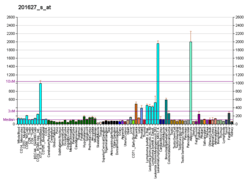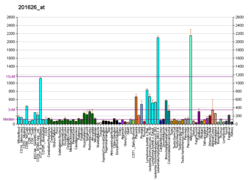Insulin-induced gene 1 protein
Insulin induced gene 1, also known as INSIG1, is a protein which in humans is encoded by the INSIG1 gene.[5][6]
INSIG1 is short for insulin-induced gene 1; it is located on chromosome 7 (7q36). This human gene encodes for a transmembrane protein of 277 amino acids with probably 6 transmembrane domains. It is localized in the endoplasmic reticulum (ER) and seems to be expressed in all tissues, especially in liver. This gene is called an insulin-induced gene because the molecule insulin can regulate it. Importantly, the protein encoded by this gene plays a critical role in regulating cholesterol concentrations in cells.
Function
- INSIG1 plays an important role in the SREBP-mediated regulation of cholesterol biosynthesis: by binding to the sterol-sensing domain of SCAP (SREBP cleavage activating protein) it makes the SCAP/SREBP complex stay longer in the ER, thus prohibiting SCAP from carrying activated SREBP to the golgi complex. This ultimately blocks SREBP from acting as a transcription factor for the SRE in the promoter region of the HMG-CoA-reductase gene and results in a decreased expression of HMG-CoA-reductase.
- INSIG1 also binds to the sterol-sensing domain of HMG-CoA-reductase, resulting in the enzyme's increased degradation.
Both functions require the binding of INSIG1 protein via the same site.
There are two other proteins whose sterol-binding sites show a great similarity to the ones of SCAP and HMG-CoA-reductase and who might thus be regulated by INSIG1 as well:
- Niemann-Pick disease type C1 protein, which participates in the intracellular movement of cholesterol
- Patched, the receptor for Hedgehog, a protein that contains covalently bound cholesterol
Oxysterols regulate cholesterol homeostasis through liver X receptor (LXR) and sterol regulatory element-binding protein (SREBP) mediated signaling pathway. This protein binds to the sterol-sensing domains of SREBP cleavage-activating protein (SCAP) and HMG CoA reductase, and is essential for the sterol-mediated trafficking of the two proteins. Alternatively spliced transcript variants encoding distinct isoforms have been observed.[6]
Regulation
INSIG1 is regulated by insulin and highly expressed in liver.
Sequence (277 AA)
MPRLHDHFWS CSCAHSARRR GPPRASTAGL PPKVGEMINV SVSGPSLLAA HGAPDADPAP RGRSAAMSGP EPGSPYPNTW HHRLLQRSLV LFSVGVVLAL VLNLLQIQRN VTLFPEEVIA TIFSSAWWVP PCCGTAAAVV GLLYPCIDSH LGEPHKFKRE WASVMRCIAV FVGINHASAK LDFANNVQLS LTLAALSLGL WWTFDRSRSG LGLGITIAFL ATLITQFLVY NGVYQYTSPD FLYIRSWLPC IFFSGGVTVG NIGRQLAMGV PEKPHSD
Synonyms
CL-6, INSIG-1, Insulin-induced gene 1 protein, MGC1405 (source: iHOP)
Interactions
References
- 1 2 3 GRCh38: Ensembl release 89: ENSG00000186480 - Ensembl, May 2017
- 1 2 3 GRCm38: Ensembl release 89: ENSMUSG00000045294 - Ensembl, May 2017
- ↑ "Human PubMed Reference:".
- ↑ "Mouse PubMed Reference:".
- ↑ Peng Y, Schwarz EJ, Lazar MA, Genin A, Spinner NB, Taub R (Aug 1997). "Cloning, human chromosomal assignment, and adipose and hepatic expression of the CL-6/INSIG1 gene". Genomics. 43 (3): 278–84. doi:10.1006/geno.1997.4821. PMID 9268630.
- 1 2 "Entrez Gene: INSIG1 insulin induced gene 1".
- ↑ Dobrosotskaya IY, Goldstein JL, Brown MS, Rawson RB (Sep 2003). "Reconstitution of sterol-regulated endoplasmic reticulum-to-Golgi transport of SREBP-2 in insect cells by co-expression of mammalian SCAP and Insigs". The Journal of Biological Chemistry. 278 (37): 35837–43. doi:10.1074/jbc.M306476200. PMID 12842885.
- ↑ Yang T, Espenshade PJ, Wright ME, Yabe D, Gong Y, Aebersold R, Goldstein JL, Brown MS (Aug 2002). "Crucial step in cholesterol homeostasis: sterols promote binding of SCAP to INSIG-1, a membrane protein that facilitates retention of SREBPs in ER". Cell. 110 (4): 489–500. doi:10.1016/S0092-8674(02)00872-3. PMID 12202038.
Further reading
- Peng Y, Schwarz EJ, Lazar MA, Genin A, Spinner NB, Taub R (Aug 1997). "Cloning, human chromosomal assignment, and adipose and hepatic expression of the CL-6/INSIG1 gene". Genomics. 43 (3): 278–84. doi:10.1006/geno.1997.4821. PMID 9268630.
- Kaneda A, Kaminishi M, Nakanishi Y, Sugimura T, Ushijima T (Jul 2002). "Reduced expression of the insulin-induced protein 1 and p41 Arp2/3 complex genes in human gastric cancers". International Journal of Cancer. 100 (1): 57–62. doi:10.1002/ijc.10464. PMID 12115587.
- Yang T, Espenshade PJ, Wright ME, Yabe D, Gong Y, Aebersold R, Goldstein JL, Brown MS (Aug 2002). "Crucial step in cholesterol homeostasis: sterols promote binding of SCAP to INSIG-1, a membrane protein that facilitates retention of SREBPs in ER". Cell. 110 (4): 489–500. doi:10.1016/S0092-8674(02)00872-3. PMID 12202038.
- Yabe D, Brown MS, Goldstein JL (Oct 2002). "Insig-2, a second endoplasmic reticulum protein that binds SCAP and blocks export of sterol regulatory element-binding proteins". Proceedings of the National Academy of Sciences of the United States of America. 99 (20): 12753–8. doi:10.1073/pnas.162488899. PMC 130532. PMID 12242332.
- Janowski BA (Oct 2002). "The hypocholesterolemic agent LY295427 up-regulates INSIG-1, identifying the INSIG-1 protein as a mediator of cholesterol homeostasis through SREBP". Proceedings of the National Academy of Sciences of the United States of America. 99 (20): 12675–80. doi:10.1073/pnas.202471599. PMC 130519. PMID 12242342.
- Strausberg RL, Feingold EA, Grouse LH, Derge JG, Klausner RD, Collins FS, Wagner L, Shenmen CM, Schuler GD, Altschul SF, Zeeberg B, Buetow KH, Schaefer CF, Bhat NK, Hopkins RF, Jordan H, Moore T, Max SI, Wang J, Hsieh F, Diatchenko L, Marusina K, Farmer AA, Rubin GM, Hong L, Stapleton M, Soares MB, Bonaldo MF, Casavant TL, Scheetz TE, Brownstein MJ, Usdin TB, Toshiyuki S, Carninci P, Prange C, Raha SS, Loquellano NA, Peters GJ, Abramson RD, Mullahy SJ, Bosak SA, McEwan PJ, McKernan KJ, Malek JA, Gunaratne PH, Richards S, Worley KC, Hale S, Garcia AM, Gay LJ, Hulyk SW, Villalon DK, Muzny DM, Sodergren EJ, Lu X, Gibbs RA, Fahey J, Helton E, Ketteman M, Madan A, Rodrigues S, Sanchez A, Whiting M, Madan A, Young AC, Shevchenko Y, Bouffard GG, Blakesley RW, Touchman JW, Green ED, Dickson MC, Rodriguez AC, Grimwood J, Schmutz J, Myers RM, Butterfield YS, Krzywinski MI, Skalska U, Smailus DE, Schnerch A, Schein JE, Jones SJ, Marra MA (Dec 2002). "Generation and initial analysis of more than 15,000 full-length human and mouse cDNA sequences". Proceedings of the National Academy of Sciences of the United States of America. 99 (26): 16899–903. doi:10.1073/pnas.242603899. PMC 139241. PMID 12477932.
- Yabe D, Xia ZP, Adams CM, Rawson RB (Dec 2002). "Three mutations in sterol-sensing domain of SCAP block interaction with insig and render SREBP cleavage insensitive to sterols". Proceedings of the National Academy of Sciences of the United States of America. 99 (26): 16672–7. doi:10.1073/pnas.262669399. PMC 139202. PMID 12482938.
- Sever N, Yang T, Brown MS, Goldstein JL, DeBose-Boyd RA (Jan 2003). "Accelerated degradation of HMG CoA reductase mediated by binding of insig-1 to its sterol-sensing domain". Molecular Cell. 11 (1): 25–33. doi:10.1016/S1097-2765(02)00822-5. PMID 12535518.
- Scherer SW, Cheung J, MacDonald JR, Osborne LR, Nakabayashi K, Herbrick JA, Carson AR, Parker-Katiraee L, Skaug J, Khaja R, Zhang J, Hudek AK, Li M, Haddad M, Duggan GE, Fernandez BA, Kanematsu E, Gentles S, Christopoulos CC, Choufani S, Kwasnicka D, Zheng XH, Lai Z, Nusskern D, Zhang Q, Gu Z, Lu F, Zeesman S, Nowaczyk MJ, Teshima I, Chitayat D, Shuman C, Weksberg R, Zackai EH, Grebe TA, Cox SR, Kirkpatrick SJ, Rahman N, Friedman JM, Heng HH, Pelicci PG, Lo-Coco F, Belloni E, Shaffer LG, Pober B, Morton CC, Gusella JF, Bruns GA, Korf BR, Quade BJ, Ligon AH, Ferguson H, Higgins AW, Leach NT, Herrick SR, Lemyre E, Farra CG, Kim HG, Summers AM, Gripp KW, Roberts W, Szatmari P, Winsor EJ, Grzeschik KH, Teebi A, Minassian BA, Kere J, Armengol L, Pujana MA, Estivill X, Wilson MD, Koop BF, Tosi S, Moore GE, Boright AP, Zlotorynski E, Kerem B, Kroisel PM, Petek E, Oscier DG, Mould SJ, Döhner H, Döhner K, Rommens JM, Vincent JB, Venter JC, Li PW, Mural RJ, Adams MD, Tsui LC (May 2003). "Human chromosome 7: DNA sequence and biology". Science. 300 (5620): 767–72. doi:10.1126/science.1083423. PMC 2882961. PMID 12690205.
- Dobrosotskaya IY, Goldstein JL, Brown MS, Rawson RB (Sep 2003). "Reconstitution of sterol-regulated endoplasmic reticulum-to-Golgi transport of SREBP-2 in insect cells by co-expression of mammalian SCAP and Insigs". The Journal of Biological Chemistry. 278 (37): 35837–43. doi:10.1074/jbc.M306476200. PMID 12842885.
- Li J, Takaishi K, Cook W, McCorkle SK, Unger RH (Aug 2003). "Insig-1 "brakes" lipogenesis in adipocytes and inhibits differentiation of preadipocytes". Proceedings of the National Academy of Sciences of the United States of America. 100 (16): 9476–81. doi:10.1073/pnas.1133426100. PMC 170943. PMID 12869692.
- Adams CM, Goldstein JL, Brown MS (Sep 2003). "Cholesterol-induced conformational change in SCAP enhanced by Insig proteins and mimicked by cationic amphiphiles". Proceedings of the National Academy of Sciences of the United States of America. 100 (19): 10647–52. doi:10.1073/pnas.1534833100. PMC 196858. PMID 12963821.
- Feramisco JD, Goldstein JL, Brown MS (Feb 2004). "Membrane topology of human insig-1, a protein regulator of lipid synthesis". The Journal of Biological Chemistry. 279 (9): 8487–96. doi:10.1074/jbc.M312623200. PMID 14660594.
- Engelking LJ, Kuriyama H, Hammer RE, Horton JD, Brown MS, Goldstein JL, Liang G (Apr 2004). "Overexpression of Insig-1 in the livers of transgenic mice inhibits SREBP processing and reduces insulin-stimulated lipogenesis". The Journal of Clinical Investigation. 113 (8): 1168–75. doi:10.1172/JCI20978. PMC 385408. PMID 15085196.
- Sever N, Lee PC, Song BL, Rawson RB, Debose-Boyd RA (Oct 2004). "Isolation of mutant cells lacking Insig-1 through selection with SR-12813, an agent that stimulates degradation of 3-hydroxy-3-methylglutaryl-coenzyme A reductase". The Journal of Biological Chemistry. 279 (41): 43136–47. doi:10.1074/jbc.M406406200. PMID 15247248.
- Lee JN, Ye J (Oct 2004). "Proteolytic activation of sterol regulatory element-binding protein induced by cellular stress through depletion of Insig-1". The Journal of Biological Chemistry. 279 (43): 45257–65. doi:10.1074/jbc.M408235200. PMID 15304479.
- Suchanek M, Radzikowska A, Thiele C (Apr 2005). "Photo-leucine and photo-methionine allow identification of protein-protein interactions in living cells". Nature Methods. 2 (4): 261–7. doi:10.1038/nmeth752. PMID 15782218.
- Sun LP, Li L, Goldstein JL, Brown MS (Jul 2005). "Insig required for sterol-mediated inhibition of Scap/SREBP binding to COPII proteins in vitro". The Journal of Biological Chemistry. 280 (28): 26483–90. doi:10.1074/jbc.M504041200. PMID 15899885.






